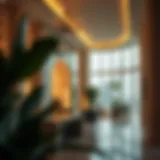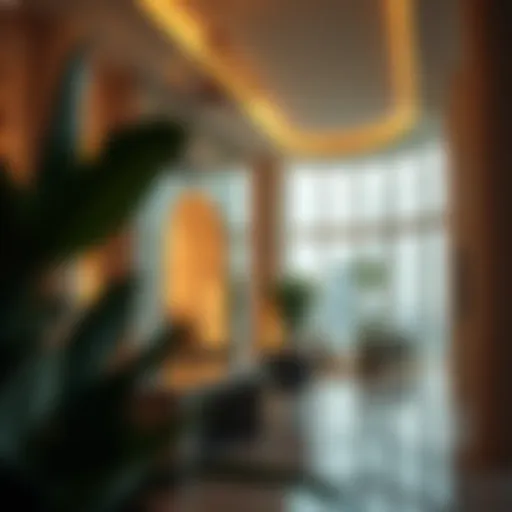Festival City Centers: Shaping Dubai's Real Estate Landscape
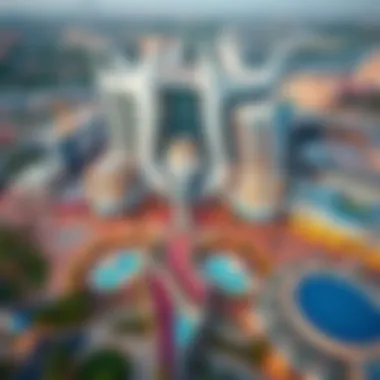

Intro
Dubai's landscape is a vibrant tapestry of culture, architecture, and commerce. Among its many establishments, festival city centers stand out as unique spaces that not only offer entertainment but also play a pivotal role in shaping the real estate market. These centers serve as bustling hubs, bringing together local residents and tourists alike, fostering a sense of community and integrating various cultural elements into the urban environment.
As Dubai continues to attract international investors, the interaction between festival city centers and the real estate market becomes increasingly significant. Understanding this relationship is crucial for those looking to navigate the complexities of property investment in this dynamic city.
In the following sections, we will explore current market trends, delve into investment opportunities, and offer insights into the changing landscape of Dubai's real estate due to the presence of these lively centers.
Understanding Festival City Centers
Festival city centers have become increasingly vital in modern urban landscapes, particularly in Dubai. These centers are not merely spaces for shopping or entertainment; they represent a blend of commerce, culture, and community interaction. By focusing on festival city centers, this article highlights their substantial role in shaping Dubai’s real estate market.
Definition and Characteristics
Festival city centers are large-scale developments typically featuring a mix of retail, dining, entertainment, and leisure options. They often host various events and festivals, catering to diverse audiences. One hallmark feature is pedestrian-friendly design, creating an inviting atmosphere for visitors. In Dubai, these centers often include recreational areas, such as parks or waterfront spaces, enhancing the overall experience for locals and tourists alike.
Equipped with state-of-the-art facilities, these centers attract businesses ranging from international brands to local artisans. This vibrant mix fosters an ecosystem where visitors can shop, dine, and engage in leisure activities all within a single venue. Moreover, the architecture and design often reflect the cultural identity of the city, making them landmarks in their own right.
Cultural Significance
Festival city centers act as cultural crossroads, bringing together various communities and fostering a sense of belonging. In Dubai, where diversity is celebrated, these hubs offer spaces for cultural exchanges, art installations, and performances that resonate with both residents and visitors. They play a crucial role in enhancing social cohesion and promoting the rich heritage and traditions of the region.
Events centered around holidays or local festivals attract large crowds, thus enhancing community engagement. For instance, during Ramadan, festival city centers might host iftar events and cultural exhibits that not only celebrate the occasion but also draw individuals from different backgrounds together. This intermingling can transform a simple shopping trip into a shared experience, emphasizing the importance of cultural identity in a cosmopolitan city.
Key Examples Globally
Globally, festival city centers have been established in various forms, each adapting to local contexts yet sharing common characteristics.
- Schaumburg, Illinois (Woodfield Mall): Often considered a pioneer of festival shopping centers, it combines shopping, entertainment, and dining, attracting millions yearly.
- Dubai Festival City: This center encapsulates the essence of what a festival city should be, offering waterfront dining alongside year-round events. Its unique attraction, the IMAGINE show, integrates lasers, water, and light to create spectacular performances.
- Mall of America, Minnesota: Beyond traditional shopping, this venue includes indoor amusement parks and aquariums, turning retail spaces into full-fledged entertainment destinations.
These examples illustrate that festival city centers are not merely about commerce; they encapsulate experiences and bring communities together. In a vibrant place like Dubai, their importance cannot be understated, as they help anchor the city’s escalating real estate market.
Festival city centers are not only retail spaces; they redefine urban living by merging culture, commerce, and community engagement seamlessly.
By understanding these elements, investors, real estate buyers, and developers gain critical insights into the implications of festival city centers on the broader market dynamics in Dubai. This knowledge proves invaluable for navigating this thriving and complex real estate landscape.
The Evolution of Festival Cities in Dubai
The evolution of festival cities in Dubai is not just a tale of bricks and mortar but a narrative of cultural richness and economic vitality. These centers embody the pulse of community life, reflecting both tradition and modernity. They're crucial in shaping the city's identity and its real estate landscape. Understanding this evolution offers insights into market movements and investment opportunities.
Historical Context
The transformation of Dubai into a vibrant city began in the late 20th century, but the concept of festival cities traces back to earlier endeavors. The establishment of the Dubai Shopping Festival in 1996 marked a significant turning point. Initially aimed at stimulating retail activity, this event gradually grew to encompass various cultural elements, shaping the city's landscape as a hub for tourism and commerce.
As the years rolled on, other notable events followed, such as the Dubai Food Festival and the Dubai Summer Surprises. These occasions not only showcased the cultural diversity of the region but also played a pivotal role in the urban development process. An ecosystem sprang to life, accommodating not just shopping but entertainment, arts, and gourmet experiences.
This historical backdrop sets the stage for current developments. Festival centers can be seen as more than just locations; they're part of a tapestry weaving together the city’s past, present, and future aspirations.
Development Timeline
The growth trajectory of festival cities in Dubai has been remarkable. Below are key milestones that define this journey:
- 1996: The inception of the Dubai Shopping Festival sparked enthusiasm among locals and tourists alike, laying groundwork for future festivals.
- 2000s: Rapid urbanization took hold with the introduction of mega-projects like the Burj Khalifa and Dubai Mall. These establishments embraced festival concepts, integrating entertainment zones and shopping experiences.
- 2010: The Dubai Food Festival was launched, further diversifying the festival offerings and attracting various stakeholders.
- Today: Festival city centers now stand as integrated hubs; evolving with continuous developments to include residential, commercial, and cultural spaces, all tailored to enhance community interaction.
Continued investments in infrastructure and a commitment to hosting world-class events shape the future of these centers, making them appealing to prospective investors.
Impact of Global Events
Global events have had a profound influence on the evolution of festival cities in Dubai. These occurrences, first seen on the international stage, have not only prompted localized marketing strategies but have also attracted foreign investors.
In the wake of significant expositions such as Expo 2020, Dubai aimed to showcase itself as a global city, further consolidating its role as a festival hub. This event was a game-changer, fostering an environment ripe for investment in both commercial and residential real estate.
Moreover, such events often lead to increased tourism, which, in turn, stimulates demand for housing and retail spaces in and around festival city centers. The culture of festivals draws international crowds, promoting a diverse economic ecosystem, and enhancing the overall appeal of real estate offerings.
Real Estate Dynamics Around Festival Centers
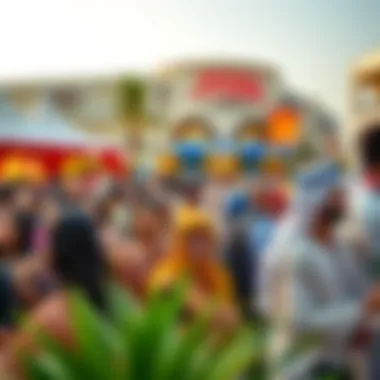

The emergence of festival city centers in Dubai has not only transformed the cultural landscape of the city but has also redefined its real estate dynamics. These areas, designed to be vibrant hubs of entertainment and social interaction, are increasingly becoming focal points in the property market. The interconnection between festival activities and real estate trends is critical in understanding the value these centers bring to both community life and investors alike.
Property Market Trends
The property market surrounding festival city centers is marked by a distinctive trend of rising demand and value. When these centers host various events, foot traffic swells, drawing in visitors and locals alike. As a result, this influx fosters a unique ecosystem that boosts property prices. The presence of attractions such as malls, parks, and concert venues creates a desirability factor that enhances the appeal of real estate in these locations.
Several key trends are notable in this context:
- Increased Commercial Investments: Investors are recognizing the potential for high returns on properties near festival hubs. Businesses flock to these locations, leading to a surge in commercial spaces, which in turn drives up real estate values.
- Urban Tick-Up: Properties within close proximity to festival centers often see a increase in valuation as people seek homes that provide convenience and access to entertainment.
- Rental Market Demands: Short-term rental markets often thrive in these areas, as tourists favor locations that offer rich experiences.
With these trends, stakeholders need to be vigilant and adjust strategies accordingly, ensuring they are well-positioned to capitalize on the ongoing momentum.
Commercial vs. Residential Developments
In Dubai, the balance between commercial and residential developments around festival city centers is a topic of ongoing discussion. On one hand, commercial entities like shops and dining venues amass around these centers, riding the coattails of increased consumer traffic. On the other hand, there is a growing need for residential developments to cater to the influx of people, both locals and expatriates, looking for homes in lively neighborhoods.
Key considerations in this balance include:
- Mixed-Use Developments: Combining residential units with commercial spaces creates synergy. These developments ensure the vibrancy of the community while providing convenient amenities within walking distance for residents.
- Zoning Regulations: Local government policies often dictate what can be built, affecting the types of properties that emerge in these areas. Understanding these regulations is essential for potential investors and developers.
Valuation Influences
Valuation in the vicinity of festival city centers is influenced by myriad factors. For instance, the overall economic health, demographic trends, and, importantly, the frequency and scale of events in the centers all play a significant role. Properties here are not just bricks and mortar; they symbolize lifestyle accessibility and cultural vibrancy.
Several influencers on valuation are worth noting:
- Event Frequency: Higher event frequency correlates with increased footfall, thus boosting property desirability, which can escalate valuations.
- Affluent Demographics: The demographic profile of visitors and residents also influences valuations. Areas attracting professionals and high-net-worth individuals will naturally see properties achieving higher market prices.
- Infrastructure Development: Investments made in public transport and connectivity to the wider city enhance location attractiveness, further supporting higher valuations.
In summary, understanding the interplay between festival city centers and real estate dynamics unfolds layers of opportunity for investors, developers, and residents alike. As these hubs continue to evolve, so will the strategies to navigate the real estate landscape surrounding them.
"The intersection of culture and commerce holds potential for robust real estate growth. Investors need to look beyond mere numbers; they must recognize the life that lingers in these centers."
For more insights into real estate trends, you might find additional resources at Wikipedia or Investopedia.
Economic Impact of Festival City Centers
The economic landscape of Dubai has been significantly shaped by the emergence of festival city centers, which have evolved into focal points for commerce, culture, and community engagement. By establishing these centers, Dubai has harnessed their potential to attract investment and generate employment. These developments not only boost the economy but also influence property dynamics in the region.
Revenue Generation
Festival city centers serve as catalysts for economic growth in Dubai by generating substantial revenue. They attract both residents and tourists, contributing to various sectors including retail, dining, and entertainment. Large festivals and events held within these centers draw crowds, ultimately enhancing consumer spending. The influx of visitors during such events provides a direct financial boost to local businesses.
Consider this:
- Increased Foot Traffic: An increase in foot traffic during festivals leads to higher sales for retailers and eateries.
- Event Sponsorship and Partnerships: Businesses often engage in sponsorships or partnerships during events to increase their visibility, thus generating more revenue.
These in turn translate into higher tax revenues for the city, enabling it to invest in infrastructure and public services that benefit the community. Festivals such as the Dubai Shopping Festival and the Dubai Food Festival exemplify how these city centers can create significant revenue streams by attracting an international audience.
Job Creation
The establishment of festival city centers has a direct effect on job creation in the area. From construction to operation, these centers create a range of employment opportunities. As many festival centers host large-scale events, they require staffing for various roles like security, event management, and hospitality.
Moreover, the surge in consumer traffic requires local businesses to hire more staff.
- Service Sector Jobs: Increased visitors mean more jobs in the restaurant, retail, and service sectors, which are typically labor-intensive.
- Permanent Positions: Festival centers also lead to long-term job creation, especially in management and maintenance roles as these facilities require ongoing operational support.
As a result, the economic impact extends beyond immediate financial benefits. The overall job growth contributes to a stable community, fostering further investment and growth in the real estate market, as people seek housing in these thriving areas.
Investment Opportunities
The presence of festival city centers creates fertile ground for diverse investment opportunities. Investors, whether local or international, see potential not just in commercial spaces but also in residential developments that can benefit from the increased demand for housing.
Various factors make these centers appealing to investors:
- High Footfall Areas: Properties in and around festival city centers typically experience higher demand due to increased visitor traffic and the cultural significance of the events.
- Potential for Mixed-Use Developments: Festival centers often encourage mixed-use developments. Investors can tap into the synergy between residential, commercial, and recreational spaces.
- Long-Term Value Appreciation: As Dubai continues to grow as a global destination, properties near festival city centers are likely to appreciate in value, offering long-term returns.


Urban Planning and Development Strategies
Urban planning and development strategies play a crucial role in shaping the landscape of Dubai, especially concerning its festival city centers. As these areas transform into hubs of activity and interaction, thoughtful urban planning ensures not only the functionality of these spaces but also their ability to foster community and enhance real estate value. The importance of strategic planning in these vibrant locales cannot be overstated, as it directly influences economic growth, social cohesion, and overall quality of life.
Infrastructure Development
A well-planned infrastructure is the backbone of any successful urban center. In the context of Dubai's festival city centers, infrastructure development involves a comprehensive approach to transportation, utilities, and public amenities. The accessibility of these areas often determines their attractiveness to both investors and visitors.
For instance, enhanced public transport options such as metro lines, bus services, and pedestrian pathways are vital. They connect festival centers with residential neighborhoods, making it easier for residents and tourists to access cultural and recreational offerings without needing to own a car. Additionally, effective road networks facilitate smooth traffic flow, a critical factor in a bustling city like Dubai where congestion can quickly become a nuisance.
Moreover, utility infrastructure, including water, electricity, and internet connectivity, must be robust and reliable to support the variety of events that take place in these centers. It’s not just about having the physical structures in place; it’s about ensuring that they meet the growing demands of future developments.
Sustainability Considerations
Sustainability has risen to prominence in urban planning, and festival city centers are no exception. Adopting green building principles, utilizing renewable energy sources, and enhancing green spaces are essential to creating environmentally friendly urban environments.
When designing these centers, factors like energy efficiency and waste management systems come into play. For example, many recent buildings in Dubai opt for solar panels and energy-efficient cooling systems. This not only reduces the carbon footprint but also appeals to environmentally conscious investors and residents. By prioritizing sustainability, festival centers can become pivotal examples of how urban spaces can thrive while respecting the environment.
To facilitate sustainable practices, partnerships with green tech companies and local governments can be beneficial. Programs focusing on recycling and community education can elevate local engagement, making residents more invested in their neighborhoods.
Smart City Initiatives
As technology continues to evolve, so does the concept of a smart city. Festival city centers in Dubai are embracing this trend through the incorporation of technology in their planning and development strategies. Smart city initiatives can enhance the functionality of urban spaces in several ways.
One key area is the integration of smart infrastructure. Sensors can monitor everything from traffic flows to energy consumption, offering data that can inform future improvements. Such innovations allow for real-time adjustments that enhance the day-to-day functioning of these centers, contributing to a better experience for visitors and residents alike.
Additionally, mobile applications can facilitate interaction among residents, local businesses, and city planners. By providing platforms for feedback and communication, these technologies help ensure that the development aligns with the needs and preferences of the community.
Summary
The intersection of urban planning, infrastructure, sustainability, and technology in the festival city centers of Dubai sets the stage for not only cultural enrichment but also robust real estate opportunities. These development strategies enhance the desirability of the area, paving the way for future investments and a flourishing community.
Key Insight: As festival city centers evolve, integrating strategic urban planning methods remains essential for maximizing their potential while addressing the diverse needs of the population.
For more information on smart cities and sustainable development, visit Wikipedia.
Festivals and Events: A Catalyst for Growth
Festival city centers in Dubai serve as pivotal focal points for community interaction and economic stimulation. They are not just venues for festivities; they play a significant role in shaping local economies and providing a backdrop for cultural expressions. The dynamic programming and activities offered here create a lively atmosphere that attracts residents and tourists alike, resulting in a ripple effect on real estate trends and investment opportunities.
Role of Cultural Activities
Cultural events form the bedrock of festival city centers. They serve to unite diverse communities through shared experiences and values, fostering social cohesion. Activities such as art exhibitions, music festivals, food fairs, and traditional celebrations not only entertain but also educate attendees about local customs and heritage.
When vibrant cultural events are hosted regularly, it enhances the image of the surrounding neighborhoods and adds a unique flavor that attracts potential investors. It often leads to increased property values as people seek to live closer to these cultural hotspots. As the saying goes, "You don’t know what you’ve got till it’s gone;" this is certainly true for vibrant urban spaces. Cultural activities can also uplift local identity, making neighborhoods feel more connected and appealing both for residents and prospective buyers.
Promoting Local Businesses
Festival city centers function as a launchpad for local businesses. During events, vendors, artisans, and small enterprises have the chance to showcase their products. This boosts not just their visibility but also helps in fostering a sense of community. When local businesses flourish, they further enrich the local economy and provide employment opportunities.
Moreover, collaboration with local entrepreneurs can be a game-changer. City centers often allow small businesses to feature their offerings during major festivals, which increases foot traffic exponentially. This direct interaction between consumers and entrepreneurs can lead to increased customer loyalty. Successful local enterprises often result in increased demand for commercial real estate as more businesses look to establish themselves near these bustling hubs.
- Increased Customer Engagement: Events that attract crowds also create bite-sized opportunities for local businesses, giving them a stage to reach new customers.
- Networking Opportunities: Festivals often become networking hotspots, allowing businesses to forge partnerships and collaborations that can lead to greater economic stability.
Enhancing Tourism Appeal
Tourism plays a central role in Dubai’s economy, and festival city centers are critical in enhancing this appeal. They not only attract local residents but also draw international tourists looking for unique experiences. Festivals that showcase gastronomy, arts, and local culture create an irresistible allure. Quite simply, the more unique and memorable the experience, the higher the likelihood of tourists sharing their visits through word-of-mouth and social media.
For instance, the Dubai Shopping Festival and the Dubai Food Festival magnetize hordes of visitors, leading to increased hotel bookings and hospitality services. This influx of tourists magnifies the demand for various services, including hospitality and retail, offering potential investment opportunities in related real estate sectors. Festivals become the lifeblood of the tourism ecosystem, and the resulting economic activity can dramatically influence property values and living costs in the surrounding areas.
"Culture can’t be severed from the economy; festival city centers could make or break local businesses."
Challenges Faced by Festival City Centers
In the dynamic landscape of festival city centers in Dubai, it’s crucial to examine the challenges that these centers encounter. While they play a transformative role in the real estate market, they are not without hurdles. Acknowledging and understanding these challenges is pivotal for stakeholders, including investors, developers, and buyers, in charting a successful course in this vibrant market.
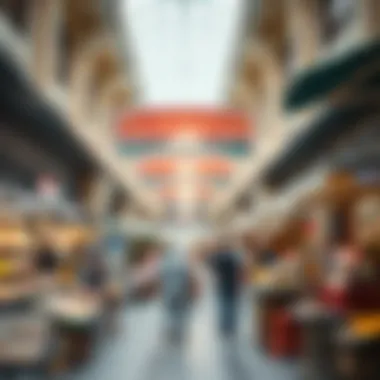

Economic Fluctuations
The ever-changing economic climate poses a significant threat to the growth of festival city centers. In times of economic downturns, discretionary spending often takes a hit. Individuals may prioritize basic needs over luxury experiences. Festivals, which heavily rely on consumer participation and spending, can witness a sharp decline in attendance and revenue generation during such times.
Moreover, fluctuations in global markets can directly affect Dubai's economy, given its interconnectedness with international players. Real estate prices may wobble with investors sitting on the fence, uncertain about future returns. Developers might scale back on projects or delay launches, leading to potential market stagnation. Strong economic fluctuations can create an environment of uncertainty, forcing stakeholders to be cautious and adapt their strategies.
Competition from Other Cities
Dubai is not a solitary beacon in the realm of festival city centers. Increasingly, other global cities are stepping up their game, implementing unique strategies to attract tourists and residents alike. Cities like Doha and Abu Dhabi are investing heavily in their own festival infrastructure, hosting high-profile events that compete for the same tourist dollars.
This competition not only threatens to divert attention from Dubai’s offerings but can also lead to price wars, impacting the profitability of existing festival centers. If developers and operators don’t innovate and differentiate their offerings, they risk losing relevance in a saturated market. Therefore, understanding competitor dynamics is essential to ensure that Dubai remains the preferred destination for both tourism and investment.
Balancing Development and Heritage
One of the toughest balancing acts for Dubai's festival city centers is striking a harmonious relationship between modern development and cultural heritage. The emirate is known for its ambitious projects and architectural marvels, yet there’s a growing need to respect and preserve its rich cultural roots.
Neglecting heritage can alienate the very community that festival centers aim to engage. To maintain authenticity, it’s crucial for developers to integrate cultural elements into their projects rather than opting for a cookie-cutter, globalized approach. Not only does this resonate with residents, but it also enhances the overall visitor experience, drawing individuals looking for more than just shopping and entertainment.
Future Prospects of Festival City Centers
The future of festival city centers in Dubai is not just a flicker on the horizon; it’s a whole new vista brimming with potential. As real estate markets continue to evolve, these cultural hubs are becoming increasingly vital in shaping the urban landscape. The convergence of lifestyle, culture, and commerce positions them as linchpins for future developments. They provide a unique platform that nurtures community spirit while fostering an economic ecosystem conducive to long-term growth.
Emerging Trends
Several trends are starting to surface that underscore the relevance of festival city centers in the real estate arena. For starters, there’s the growing focus on mixed-use developments. These projects seamlessly integrate residential spaces, commercial outlets, and recreational facilities in one locale, catering to the diverse needs of residents and visitors alike. This balance helps in maximizing the land’s use efficiently, making properties in these areas more desirable.
Another trend is the emphasis on experiential living. Consumers are increasingly drawn to places that offer more than just bricks and mortar; they want experiences that enrich their lives. This trend is leading developers to build spaces that merge living with leisure and social activities, effectively turning festival city centers into social magnets.
Keep an eye on:
- Adaptive reuse of existing structures
- Community spaces that encourage creativity and innovation
- Localized events that respond to cultural trends
Impact of Technology
Technology is also set to alter the landscape profoundly. Smart city initiatives are gaining ground, aiming to create interconnected environments that elevate quality of life. Investments in technology have already started reshaping how urban areas function, particularly in festival city centers. Imagine integrated apps that provide real-time updates on cultural events or demographics of foot traffic patterns to optimize commercial opportunities.
Adding to this, augmented reality (AR) is making waves in the real estate sector. Whenever potential buyers or investors can visualize a creative concept for a new property digitally, they become more interested, thereby boosting marketability.
"The intersection of technology and community engagement is a game changer for festival city centers. It enhances the overall experience than what traditional methods can offer."
Long-term Sustainability
Sustainability is no longer an option; it has become a necessity. The responsible management of resources is a crucial aspect of future planning for festival city centers. Incorporating eco-friendly practices not only meets today's consumer demands but enhances property values in the long run.
To maintain their relevance, stakeholders are considering:
- Green building certifications, ensuring that new developments meet high environmental standards.
- Sustainable transport options that ease congestion and enhance accessibility.
- Community involvement in planning to ensure that developments are in line with local needs.
The growing commitment to durability reflects changing attitudes towards environmental stewardship, making festival city centers more appealing to discerning investors.
As these aspects develop, the festival city centers of Dubai will play a pivotal role in cementing its position as a vibrant, engaging, and sustainable real estate market for years to come.
Epilogue: The Strategic Importance of Festival City Centers
Festival City Centers in Dubai stand as an essential pillar in the intricate framework of the city's real estate market. They serve not just as commercial hubs, but as vibrant community spaces where various facets of culture and commerce intertwine. Understanding their strategic importance hinges on several key elements that illustrate their role in economic development and urban living.
Summary of Key Insights
In revisiting the main points of discussion, it becomes evident that Festival City Centers offer more than just retail experiences. They have become catalysts for economic prosperity, engaging residents and attracting tourists alike. The integration of leisure, dining, and entertainment within these centers amplifies their draw, driving foot traffic that translates directly into higher property values nearby. Furthermore, festival city centers promote community cohesion and facilitate social interactions, which are crucial in a multicultural society like Dubai.
- Economic Growth: Their presence fosters job creation, contributing to the local economy's expansion.
- Real Estate Valuation: Proximity to these centers often enhances property values, proving them as sound investments for buyers and developers.
- Cultural Fusion: They symbolize a blend of local heritage and global influences, enriching the cultural tapestry of Dubai.
The developments within these centers are likely to adapt alongside changing societal trends, ensuring relevance and sustainability in the long term.
Final Thoughts on Real Estate Influence
The influence of Festival City Centers on Dubai's real estate market transcends mere property dynamics. As hubs of activity, they set the stage for various economic interactions and forge a unique identity for their surrounding neighborhoods. Investors, both local and international, should pay close attention to the developments within these spaces as opportunities abound not only for commercial gain but for investing in lifestyle and community-building ventures.
As we glance towards the future, festival city centers will likely continue to play a pivotal role in shaping the urban landscape, and by extension, the real estate market. Understanding this relationship opens avenues for strategic investments, insightful property developments, and informed decisions that capitalize on this evolving aspect of Dubai's identity.
"Festival city centers are not just about retail; they reflect a socio-economic ecosystem that is foundational to the urban experience."


